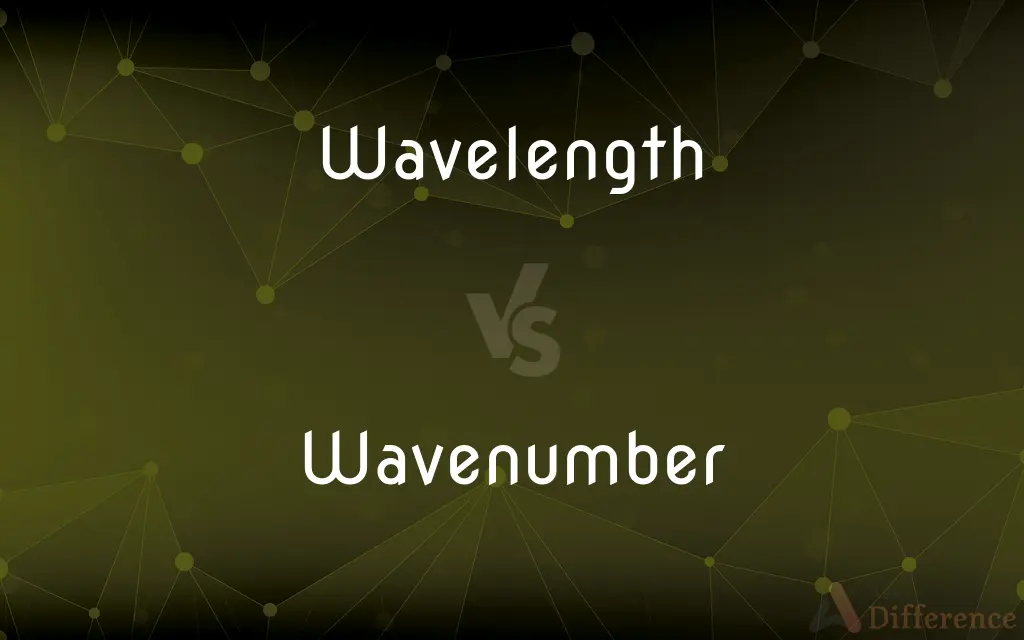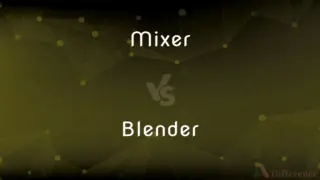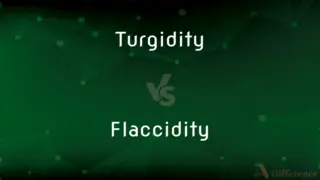Wavelength vs. Wavenumber — What's the Difference?
Edited by Tayyaba Rehman — By Fiza Rafique — Updated on October 10, 2023
Wavelength is the distance between successive wave peaks; wavenumber is the number of wave cycles per unit distance.

Difference Between Wavelength and Wavenumber
Table of Contents
ADVERTISEMENT
Key Differences
Wavelength and wavenumber are both vital concepts in the study of waves, especially in the realm of physics and optics. Wavelength refers to the distance between two consecutive crests (or troughs) of a wave. In a visible light spectrum, different colors are discernible because of their unique wavelengths. On the other hand, wavenumber, often denoted by the symbol ν (nu), is the spatial frequency of a wave, defined as the number of wave cycles in a given unit of distance.
Wavelength, usually symbolized by the Greek letter λ (lambda), is typically measured in meters (m) or nanometers (nm) for light waves. In sound waves, it might be described in terms of meters or centimeters. Wavenumber, inversely related to wavelength, provides information about the spatial characteristics of a wave, indicating how many wave cycles occur in a specific distance. It is often expressed in reciprocal meters (m^-1) or cm^-1.
In many spectroscopic techniques, wavenumber plays a crucial role, especially in infrared (IR) spectroscopy. Here, molecules are identified based on their unique vibrational frequencies, which are typically represented in terms of wavenumber. Conversely, when discussing the spectrum of visible light, we often refer to wavelength to differentiate colors.
A concise way to relate wavenumber and wavelength is through their inverse relationship. As the wavelength of a wave increases, its wavenumber decreases and vice versa. For example, blue light has a shorter wavelength and thus a higher wavenumber compared to red light.
In applications, both wavenumber and wavelength serve as essential tools for understanding and manipulating waves. For instance, in telecommunications, knowledge of the wavelength can guide the design of antennas and transmitters. At the same time, in molecular spectroscopy, the wavenumber can help identify and study specific molecular structures and bonds.
ADVERTISEMENT
Comparison Chart
Definition
Distance between successive crests
Number of wave cycles per unit distance
Measurement Unit
Meters (m) or Nanometers (nm)
Reciprocal meters (m^-1) or cm^-1
Relation
Inversely related to wavenumber
Inversely related to wavelength
Common Use
Differentiating colors in light
Identifying molecules in IR spectroscopy
Symbol
λ (lambda)
ν (nu)
Compare with Definitions
Wavelength
Wavelength refers to the spatial period of a wave.
Green light has a specific wavelength, making it appear green to our eyes.
Wavenumber
Wavenumber is inversely related to wavelength.
A higher wavenumber corresponds to a shorter wavelength.
Wavelength
Wavelength determines the color of light in the visible spectrum.
Blue has a shorter wavelength than red.
Wavenumber
Wavenumber is frequently used in infrared spectroscopy.
Infrared spectra are typically plotted against wavenumber.
Wavelength
Wavelength is a property that defines the size of oscillations in wave phenomena.
Microwaves have a longer wavelength than X-rays.
Wavenumber
Wavenumber is the number of wave cycles per unit distance.
The wavenumber gives insight into the spatial characteristics of a wave.
Wavelength
Wavelength is the measure of the distance over which a wave's shape repeats.
The sound waves from a bass guitar have longer wavelengths than those from a flute.
Wavenumber
Wavenumber provides the spatial frequency of a wave.
Vibrations of certain molecules can be identified by their unique wavenumbers.
Wavelength
Wavelength is the distance between two consecutive crests of a wave.
The radio waves have a longer wavelength than visible light.
Wavenumber
Wavenumber is the reciprocal of the wavelength in spatial frequency terms.
As the wavenumber increases, the wavelength decreases.
Wavelength
In physics, the wavelength is the spatial period of a periodic wave—the distance over which the wave's shape repeats. It is the distance between consecutive corresponding points of the same phase on the wave, such as two adjacent crests, troughs, or zero crossings, and is a characteristic of both traveling waves and standing waves, as well as other spatial wave patterns.
Wavenumber
In the physical sciences, the wavenumber (also wave number or repetency) is the spatial frequency of a wave, measured in cycles per unit distance or radians per unit distance. Whereas temporal frequency can be thought of as the number of waves per unit time, wavenumber is the number of waves per unit distance.
Wavelength
The distance between one peak of a wave to the next corresponding peak, or between any two adjacent corresponding points, defined as the speed of a wave divided by its frequency.
Wavenumber
A measure of the number of waves in unit distance; inversely proportional to its wavelength.
Wavelength
(physics) The length of a single cycle of a wave, as measured by the distance between one peak or trough of a wave and the next; it is often designated in physics as λ, and corresponds to the velocity of the wave divided by its frequency.
Wavelength
(figurative) A person's attitude and way of thinking as compared to another person's.
I think you and I are on a different wavelength.
Wavelength
The distance (measured in the direction of propagation) between two points in the same phase in consecutive cycles of a wave
Wavelength
A shared orientation leading to mutual understanding;
They are on the same wavelength
Common Curiosities
How is wavenumber defined?
Wavenumber is defined as the number of wave cycles per unit distance.
Which is longer, the wavelength of red light or blue light?
The wavelength of red light is longer than blue light.
Is wavenumber typically used in infrared spectroscopy?
Yes, wavenumber is commonly used in infrared (IR) spectroscopy to identify molecules.
What is a wavelength?
Wavelength is the distance between successive crests or troughs of a wave.
Are wavelength and wavenumber directly proportional?
No, they are inversely proportional.
Which has a higher wavenumber, radio waves or ultraviolet waves?
Ultraviolet waves have a higher wavenumber than radio waves.
What units are commonly used for wavenumber?
Wavenumber is usually expressed in reciprocal meters (m^-1) or cm^-1.
Can wavelength be used to identify molecules like wavenumber?
While both can offer insights, wavenumber is more commonly used in spectroscopy for molecular identification.
How are wavelength and color related?
In the visible spectrum, different colors are discerned based on their unique wavelengths.
Does a shorter wavelength mean a higher wavenumber?
Yes, a shorter wavelength corresponds to a higher wavenumber.
How do wavelength and frequency relate to the speed of a wave?
The speed of a wave equals the product of its frequency and wavelength.
Is wavenumber dependent on the medium in which a wave travels?
Yes, wavenumber can be affected by the properties of the medium.
Which provides more information about the spatial characteristics of a wave, wavelength or wavenumber?
Wavenumber provides more detailed spatial information about a wave than wavelength.
In which domain is wavenumber most prominently used?
Wavenumber is prominently used in the domain of molecular spectroscopy, especially infrared spectroscopy.
How can one convert between wavelength and wavenumber?
Wavenumber (ν) is the reciprocal of the wavelength (λ), ν = 1/λ.
Share Your Discovery

Previous Comparison
Mixer vs. Blender
Next Comparison
Turgidity vs. FlaccidityAuthor Spotlight
Written by
Fiza RafiqueFiza Rafique is a skilled content writer at AskDifference.com, where she meticulously refines and enhances written pieces. Drawing from her vast editorial expertise, Fiza ensures clarity, accuracy, and precision in every article. Passionate about language, she continually seeks to elevate the quality of content for readers worldwide.
Edited by
Tayyaba RehmanTayyaba Rehman is a distinguished writer, currently serving as a primary contributor to askdifference.com. As a researcher in semantics and etymology, Tayyaba's passion for the complexity of languages and their distinctions has found a perfect home on the platform. Tayyaba delves into the intricacies of language, distinguishing between commonly confused words and phrases, thereby providing clarity for readers worldwide.















































